The Evolving Economic Tale of Hong Kong and Shenzhen
A tale of 2 cities--a green, modern, and tech hub city in China, Shenzhen, next to the international financial centre of Hong Kong

Today, I will share with you a travel log and my reflections on the legendary cities of Hong Kong and Shenzhen. I hope you like it, and please feel free to share it.
Feel free to check out my newsletter where I write about the market, investment, wealth creation, wellness ideas, and things I learn about AI/productivity.
Times Have Changed
Before COVID in 2018, Hong Kong, a major tourism city, welcomed 65 million total international visitors, around 79% from mainland China, or about 51 million.
Our Shenzhen brethren used to look across to see the prosperous Hong Kong city and indulge in Cantonese pop songs.
From luxury items to baby formulae, the Chinese visitors spent enthusiastically on items they could not find at home. They came in big tour buses, which parked in front of shops and residential areas often blocking traffic, shops, and homes, with the local people calling for the government to restrict residents of the neighbouring city of Shenzhen from visiting Hong Kong once a month instead of once a week.
Then COVID hit. The China-Hong Kong border was closed.
Mainland Chinese (and other) visitors to Hong Kong dwindled to almost nothing by 2021 with a much-needed rebound to 26.7 million in 2023. In 1H 2024, total visitors to Hong Kong have risen to 21 million, with 16 million (73%) from mainland China.
On the other hand, Hong Kong people began visiting Shenzhen en masse since the border re-opened in January 2023, shopping (in malls, Sam Club, COSTCO), dining, touring, savouring multiple services (dental treatments, haircuts, massages, getting eyeglasses, medical services, etc.), and relaxing in hotels in Shenzhen.
About 49.5 million departed from HK in 1H 2024, 44 million (~89%) to mainland China. UBS estimated Hong Kong people spent about 10% of total retail sales in Shenzhen by the end of 2023.
The 3-day national holiday in HK on July 1 saw only 20% as many visitors from China visiting HK as HK residents visiting China. Retail in Shenzhen flourished while Hong Kong suffered.
What has caused this change in the economic dynamic?
Since 2021, the Chinese Renminbi has become much cheaper vs. the Hong Kong dollar, which is pegged to the US Dollar. The economy of China has weakened with prices flirting with deflation since the beginning of 2023.
To stretch their dollars, people from Hong Kong prefer to spend money in Shenzhen on groceries, food and beverages, and services—with the quality and availability of food and services coming up to par if not better than in Hong Kong. Shenzhen is not only modernized but has become much more attractive for the value of HK people’s money.

Moreover, transportation access has become more convenient for Hong Kong residents travelling to Shenzhen (there are now 11 checkpoints between HK and Shenzhen). A subway trip from Hong Kong Island to Shenzhen City takes about 1.5 hours. High-speed rail from West Kowloon in HK to Shenzhen takes about 20 minutes.

Shenzhen businesses offer discounts, varieties, and good services to lure their HK brethren to spend, while HK travel agency arranges attractive tours for Hong Kong people during weekends and public holidays.
My recent trip to Shenzhen when I visited family in Hong Kong confirmed this. I saw plenty of people from HK dining in restaurants and vacationing in nearby tourist towns.
Let’s discuss more about the geography and history of Shenzhen, and how Hong Kong and Shenzhen are linked.
Hong Kong and Shenzhen Within the Greater Bay Area, China

Greater Bay Area (GBA) consists of the nine municipalities of Guangzhou, Shenzhen, Zhuhai, Foshan, Huizhou, Dongguan, Zhongshan, Jiangmen and Zhaoqing in Guangdong Province plus the two Special Administrative Regions of Hong Kong and Macao. Hong Kong and Shenzhen share a border (see a chart later).
The total GBA area is around 56,000 km2 with a population of over 86 million and a GDP of over RMB 14 trillion (just under US$2 trillion) in 2023.
According to the Greater Bay Area website:
The development of the Greater Bay Area is accorded the status of key strategic planning in the country's [China’s] development blueprint, having great significance in the country's implementation of innovation-driven development and commitment to reform and opening-up. The objectives are to further deepen cooperation amongst Guangdong, Hong Kong and Macao, fully leverage the composite advantages of the three places, facilitate in-depth integration within the region, and promote coordinated regional economic development, with a view to developing an international first-class bay area ideal for living, working and travelling.
Shenzhen, a fishing village of 300,000 about four decades ago, became one of China’s first four special economic zones (SEZ) in the late 1970s to adopt capitalist practices ahead of the rest of China, triggered by then-Chinese leader Deng Xiaoping.
Since then, Shenzhen, focusing on fostering innovation, has earned the name of China’s Silicon Valley with tech giants such as Tencent, BYD, and Huawei being founded there.


Around early 2010, Shenzhen’s GDP (nominal in USD) started to take off, overtaking Hong Kong by 2019.
Despite having twice the population (17.8 million) as HK (7.5 million), Shenzhen has twice the area and is less dense. Shenzhen’s development is more distributed and spread out compared to Hong Kong, which is heavily concentrated on Hong Kong Island and the Kowloon peninsula, with a large part of the New Territories covered in greens and mountains.
Economic Changes in Hong Kong and China
When I was growing up in Hong Kong under the British administration (until 1997), mainland China was so close yet seemed so far.
Even though we share the same origin and philosophy as our hinterland, our dialect, habits, food, working styles, values, outlook, and interests are quite different.
Hong Kong has developed its distinct culture fusing Chinese and Western ideals. We focus on wealth creation, education, entrepreneurship, and plain old hard work and less on politics.
We look to the West for cuisines, ideas, entertainment, and knowledge. I did not watch TV from China but indulged in cartoons, shows, and dramas from Japan and America when I was young.
Hong Kong’s industrialization began in the 1950s when China was still isolated from the rest of the world. Hong Kong re-integrated with China in the late 1970s due to President Deng Xiaoping’s open-door policy. While Hong Kong transitioned from manufacturing to services in the late 1980s, China became the world’s manufacturing factory, growing leaps and bounds from 1991 until the mid-2010s.
No longer crowded and a bit sketchy, Shenzhen, the Silicon Valley of China, has attracted young Chinese to live and work there. It has a higher GDP per capita than Shanghai or Beijing. Nanshan district now hosts the headquarters of many Chinese tech giants, but Nanshan did not even exist 25 years ago. Who could have imagined?

In recent years, the government has supported the development of cultural industry, by establishing, for example, the “Shenzhen Cultural and Creative Industry Revitalisation and Development Policy.”
As a result, the planning and greening of Shenzhen have exceeded my expectations. It is not only the most modernized city in China, like Hong Kong but also a major tourist destination for the brethren from Hong Kong and Macau.

I have six observations after my trip in July to Shenzhen:
Shenzhen’s subway station resembles that of Hong Kong and is very comprehensive with 3 languages used for the announcement (Cantonese, Mandarin, and English). I felt like I was riding an HK subway although most trains are not crowded and transferring between lines involves a lot of walking.
Despite Shenzhen being the first testing ground of foreign investments for China, there were hardly any Caucasians / foreigners during my two-day visit: not in the ancient Hakka town (a tourist attraction) I visited or the restaurants (large or small) we dined at. Due to travel restrictions and political tension between China and several other major centres, the visitors remain largely local Chinese, especially those from Hong Kong and elsewhere in China.
While the quality of the upscale cuisine may see room for improvement, the price of a restaurant meal is easily 40 to 50% of that in Hong Kong with many services such as medical/dental treatment, massages, eyeglass prescriptions, theme parks a small fraction of those in Hong Kong (see table above). Even Hong Kong youth, like my nephew, enjoy spending their weekends up north.
Shenzhen has become a technological and innovative centre and a major tourist attraction for other Chinese especially those from Hong Kong and Macau. The shopping malls are first-class and spacious, and the decor carries great themes and high quality.
I was impressed by the service and care of the Shenzhen hospitality sector. The people seem to want to help and make their customers happy genuinely.
Shenzhen is a relatively young city, so city planning, construction, and its focus on greening and sustainability make it an attractive place to visit.
Is everything working and great in Shenzhen? No — for example, the subway escalators do not always work and the escalators are not as abundant in malls as in Hong Kong. Restaurant services seem slower than in HK. Many Chinese dialects exist in Shenzhen but not much English, so it is not as international as in Hong Kong. Squat toilets are still the norm everywhere, so visitors may find it hard to adapt (no squat toilets in all developed areas of HK!)





Does Hong Kong Still Have Its Attraction?
Absolutely! But it has become expensive for visitors and locals and lost its lustre and direction but not the culture, cuisines, natural beauty, convenience, internationalism, business ethics, free capital movement, and freedom (Google, WhatsApp, Wikipedia, Quora, Slack, BBC, etc. are banned in China).
My friend, a long-time finance and accounting professional, has been operating in both Hong Kong and China for over 20 years. She prefers hiring HK people, perhaps due to local HK people’s quickness of mind, Western business ethics, and adaptability to changing business conditions and client requirements.
The Hong Kong government has done many things to increase the appeal of HK to locals as well as foreigners, not only tourists but also high-earning talents. Eric Gnock Fah, co-founder and chief operating officer of the travel service platform Klook, summarized the advantages of HK well.
Hong Kong is fortunate to possess a wealth of unique attributes. Our fusion of Chinese and international cultural influences presents visitors with a captivating East-meets-West experience. Our cultural assets, such as M+, the Hong Kong Palace Museum and the internationally acclaimed Hong Kong Philharmonic Orchestra, are a testament to our rich heritage…
Hong Kong’s natural beauty and tranquillity make possible many outdoor activities that balance out the city’s vibrant urban cityscapes. Our highly regarded ultra-marathon and diverse array of running and trail events require more support from the government. As organisations hold successful signature events and the city hosts more mega events, we will continue to revitalise the tourism sector…
…We have an endless array of tantalising food options, from traditional and affordable favourites like wonton noodles, pork buns, egg tarts and milk tea to many fine dining options.
But there is more work to do, and the Hong Kong government can learn from their Shenzhen brethren to become more innovative and find ways to reduce essential costs such as drug prices, increase medical supply, provide more cultural experiences, and improve the service sector hospitality.
Many local Hong Kong locals and I are happy to see the rise of Shenzhen, providing an alternative place for us to experience life. But Hong Kong is still our home, and home is where the heart is.















